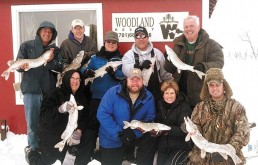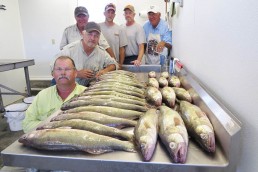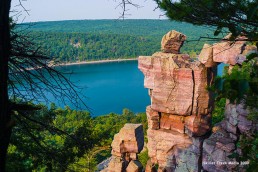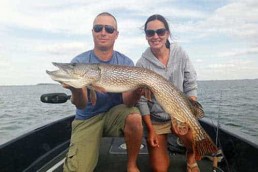Devils Lake: Walleyes, Pike and Perch at Historic Highs
I asked Kyle Blanchfield, owner of Woodland Resort on Devils Lake for 27 years, what his impression of the fishery is these days, and his first comment was: “You can’t ask for a better walleye fishery right now!”
Local anglers, outstate vacationers, and even tournament walleye pros have been boasting about Devils Lake’s great fishing for years. Now, coming off a historically good summer and fall bite, the expectations for this ice fishing season are high. With generous five-fish limits on walleyes, with no restricted slot, you can customize your creel during a day’s fishing to suit your needs. The “perfect eater” 14- to 18-inch fish are at all-time highs, plus numerous big fish prowl the lake, in case bigger is better for you.
A mid-September national walleye tournament held on Devils Lake proves the point, with five-fish limits exceeding 30 pounds recorded by some of the competitors. “The fish are fat and healthy,” says Blanchfield. “The Devils Lake walleye population is at near-record numbers, and we’re coming off of a super consistent summer and fall bite, which bodes well for the ice fishing season,” he notes.
Jon Dircks, owner of Ed’s Bait Shop in Devils Lake, concurs. “The walleye fishing is about the best it’s ever been on Devils,” he says, and suggests that if you’re schedule allows for an early-ice trip to eastern North Dakota, you might see some of the best ice fishing for walleyes you could ever imagine.
“We’ve been clobbering big walleyes on Jigging Rapalas in October,” Dircks continues, “and into the early ice period this aggressiveness will continue as these fish keep putting on the feed bag. These fall fish are incredibly fat but are still eating like crazy. A lot of times, a #9 Jigging Rap is all the way down their mouth.” He’s been sticking to UV patterns—either UV green or UV orange—for best success.
Like walleyes in all waters, when the fish are in shallow water they are aggressive, and during early ice this can mean as little as 6 to 8 feet of water on Devils Lake. As winter progresses, the fish will move to deeper rock piles and won’t feed as heavily, preferring to burn fat reserves and rest in advance of the spring spawn. Always try to find hard-bottom areas, which on Devils Lake can be riprap, old sunken road beds, rock piles, or main lake points that feature some gravel or rubble. While more difficult to locate and pattern, weedlines and sections of the lake with sunken timber can be productive as well.
As winter progresses, the key is to fish areas with some current, ideally the downcurrent sides of bridge channels/narrows, neckdown areas with constricted water flow between bays, or the backs of bays featuring some current inflow. While Devils Lake walleyes start out shallow, then move deep in midwinter, by late ice they are staging for the spawn and these current areas attract fish.
Devils Lake walleye activity is limited to the first hour or two of daylight, with a second peak during the last two hours leading up to dusk, unless the lake gets a heavy snowpack atop the ice this winter, which may increase daytime activity. Overall water clarity is poor on Devils Lake. With this in mind, a good strategy is to map out prime walleye spots to hit at morning and evening, and invest your midday fishing hours chasing the huge schools of perch that roam the Devils Lake basin. This lake is a vast, flooded impoundment, and the sheer size (200,000 acres) can be daunting to less-experienced anglers. You need to be ready to move between basins and shift gears to find the best bites and maximize your time on the ice. Many excellent guides offer services on Devils Lake, and booking a day or two (or more) with them to learn the ropes gives you the advantage of local, up-to-date knowledge about prime fishing locations and local fish-catching techniques.
North Dakota Game & Fish numbers peg Devils Lake’s current perch population on a big uptick. Area fisheries biologist Todd Caspers says the news from the netting surveys was good. “The big 2013 year-class is coming up through the system, “ he says, “and these fish are now 5 to 8 inches. In last year’s nets there were three per net, and in the most recent netting survey there were 10.” While these fish are a year or two away from becoming jumbos, the numbers of 10- to 12-inch perch—the preferred target range for ice anglers—were showing up in test nets at about double the levels of the previous year.
“We’re spoiled here when we talk about ‘jumbo perch,’ ” says Woodland’s Blanchfield. “When we say ‘jumbo’ here, we mean pound-and-a-quarter to pound-and-a-half. It’s like when you call Aspen, Colorado for a ski report and because they don’t have perfect powder, the person says ‘yeah, we’ve got some okay snow’. Devils Lake has huge perch. The wild card on perch for us every year is: will they bit consistently?”
“The big 13- to 14-inchers are out there,” says Dircks from Ed’s Bait Shop, “but not in the historically high levels of a few years ago. They got pressured pretty hard during that aggressive bite two winters ago, but you can always find big perch on Devils Lake. Finding them is easy; the catching part can be harder.” With a bag limit of 20 perch per angler, filling out your fishing trip with some tasty perch fillets should nonetheless be an easy proposition on Devils this winter.
The biggest variable affecting a consistent perch bite is freshwater shrimp, because when this invertebrate is abundant as a food source for perch, the bite can slow down. The jumbos gorge on shrimp, and while you can still catch perch, you have to be a lot more patient and work harder to trick them into biting. “Our perch can be goofy,” says Dircks, “and their moods can change, daily, hourly, by the minute even! One day they like gold, the next it’s red, and then it has to be green. When they aren’t biting aggressively, keep experimenting with colors, lure sizes, and styles, and you’ll get your fish. And always be on the move—if you’re not getting bit in 15 minutes, go find some perch that will cooperate better.”
Another positive sign, according to Blanchfield, little telltale signs this fall indicate the shrimp are at “normal” levels, and that means the optimism for a hot winter perch bite remains high.
People are likewise enthusiastic about Devils Lake northern pike fishing. Anglers can keep up to five pike (no slot limit), plus each angler can fish with as many as four lines at once, which means a fun outing for a group of tip-up anglers! Flags are flying all over the ice when the bite gets hot. “We’ve had a couple of mega-year-classes, so we’ve got a ton of those mid-range pike,” says Blanchfield. “If ice fishermen target northerns heavily this year, an 8- to 10-pound average wouldn’t surprise me at all,” although he allows that the “average” pike is probably closer to 4 to 5 pounds. Every winter, 20-pound trophy pike get caught on Devils Lake. When added to the generous walleye and perch limits, you can always go home with plenty of fish to fry, and bonus northern pike excel at keeping you busy during daytime fishing hours when the perch are slow, or while you wait for the evening walleye bite.
Devils Lake—it’s hot right now for three prime winter gamefish species. Book your North Dakota ice fishing adventure today.
MWO
SHARE THIS POST
Did you enjoy this post?
You can be among the first to get the latest info on where to go, what to use and how to use it!



